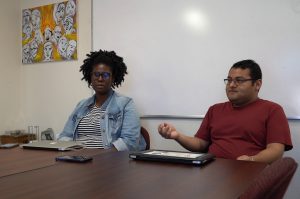By Dalton Padilla / NM News Port
The 2020 U.S. Census began on March 12. For the first time, respondents have the option to identify their national origins.
Although the Census Bureau says this latest addition to the census will provide more insights into the changing American population, it’s set off some controversy about the best way to code for race, ethnicity and national origins.
The 2020 Census offers several layers of race/origin responses
The census starts by asking if the respondent is of Hispanic, Latino or Spanish origin. The answer options are:
- No
- Yes, Mexican, Mexican-American, Chicano
- Yes, Puerto Rican
- Yes, another Hispanic, Latino or Spanish origin (with a box to write in the answer)
The next question allows the respondent to indicate their race and origins. Respondents can choose more than one box. The answer options are:
- White (with a box to write in origins)
- Black or African-American (with a box to write in origins)
- American Indian or Alaska Native (with a box to write in principal tribes)
- Chinese
- Filipino
- Asian Indian
- Vietnamese
- Korean
- Japanese
- Other Asian (with a box to write in more)
- Native Hawaiian
- Samoan
- Chamorro
- Other Pacific Islander (with a box to write in more)
- Some other race (with a box to write in more)
Under each racial category there are examples of national origins. For instance, under white there are origins like German, Irish, and English.
Adding clarity or confusion?
According to the Census Bureau, the data gathered through this question will lend itself to more refined statistics about racial groups and allow agencies to monitor anti-discrimination acts.
“What is new to the census, is that it’s linking race with nationality…and that isn’t always an accurate way to record data.”
– Erick Hernandez, co-counselor on the UNM 2020 Census Complete Count Committee
Tabitha King, a co-counselor on the UNM 2020 Census Complete Count Committee, said this level of probing can be hard for some Americans to understand.
“What’s different on the census, for the first time you can choose multiple races or multiple ethnicities,” King said. “I think that can be confusing in the way for those who are not from New Mexico.”
Erick Hernandez, another co-counselor on the committee, takes issue with the census merging questions of race and national origins.

“What is new to the census, is that it’s linking race with nationality…and that isn’t always an accurate way to record data,” Hernandez said.
Given these concerns, complete count committees like UNM’s are striving to help the census record the most accurate data.
“We are having conversations with students, holding events and press conferences to educate the general public of what the census can do for our state and community,” Hernandez said.
The UNM Complete Count Committee has held events in the past and had planned to host a census block party on April 1, 2020. The event had to be postponed due to the recent COVID-19 outbreak.
UNM President Garnett Stokes and other council members were scheduled to talk about the importance of the census. The committee plans to hold a virtual block party when it is safe to do so.
Coding for race for over 170 years
The census is written into the U.S. Constitution and has been used since 1790 to pinpoint how many people reside in the country. This data is used to allocate state funding and how many seats each state gets in the House of Representatives.
The questions regarding race and ethnicity have changed over the years, as an interactive timeline on the Census Bureau’s website displays.
Census respondents have been able to choose multiple races since 2000, according to the bureau’s timeline.
No citizenship question; concerns about response rates
One change that did not occur in 2020 was the proposed addition of a citizenship question. The Trump administration was looking into adding a question that asks, “Are you a citizen?”
The question was rejected by the U.S. Supreme Court in 2019, on the basis that it would suppress the count, but the resulting controversy has left some people confused.
“I thought the citizenship question was still on the census, even though I watch the news a lot, I swore it was on it,” Albuquerque resident Ann Harriet said.
King said that confusion surrounding this question could contribute to an undercount.
“I think people still don’t know that there isn’t a citizenship question on the census and choosing not to participate. It actually takes away funding for programs that are for people who are undocumented,” King said.
New Mexico has a history of low response rates, resulting in an undercounted population. In 2010 New Mexico had a return rate of 65%, the second lowest in the nation, with the lowest return in the state coming from Catron County at 23%.
“That’s based on a lot of validated fear of government entities, because we don’t have people participating or participating at much lower rates,” King said.
Dalton Padilla is a reporter for the New Mexico News Port. He can be reached on Twitter @DaltonOPadilla or at nmnewsport@gmail.com.